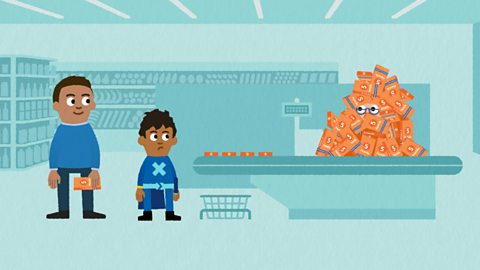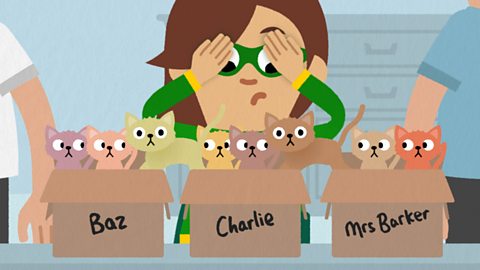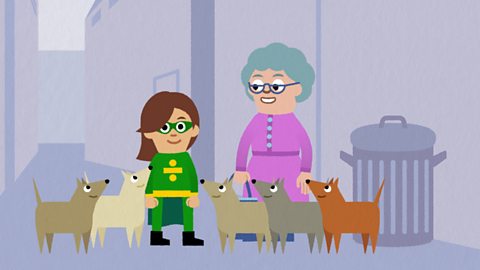Video summary
Charlie has won a huge bunch of balloons; so huge they have put him in something of a precarious position.
But heβs not going to give them up easily.
He won them fair and square after all.
Dave suggests sharing them out, so they can all help him carry them home.
This sounds like a job for Divider Girl!
Divider Girl clambers to the rescue, but a fumble of her number line leaves her grasping for other options.
Can she help Charlie to share the balloons equally without it?
Can she use multiplication facts to help with this division problem?
Will Charlie ever get his feet back on the ground?
This clip is from the series A World Without Maths.
Teacher Notes
Key Stage 1:
Children could act out sharing balloons equally, like Charlie in the story.
Or use other objects to share equally between each other.
Ask the children to carefully count out how many objects there are before they start.
If the children are not yet familiar with remainders, make sure that the number can be equally shared between the number of children in the group.
Children could also solve problems related to the story, using pictures or their multiplication facts.
Key Stage 2:
Children might solve division problems related to the story using their multiplication facts.
Encourage children to think about how many of a number make the total they are dividing.
For example, Charlie needs to arrange 36 chairs around 6 tables for the school party, how many chairs will he put at each table? How many 6s make 36? How many 6s are in 36?
This clip will be relevant for teaching Maths at KS1 and KS2 in England and Wales, and First and Second Level in Scotland.
Multiples of two, five and ten. video
Multiplication Boy and Divider Girl keep their maths superpowers sharp with a competition to count in twos, fives and tens.

Multiples of two, five and ten. video
Multiplication Boy and Divider Girl keep their maths superpowers sharp with a competition to count in twos, fives and tens.

How to use arrays to multiply. video
Multiplication Boy helps Mr Sharma buy pencils for the school, using arrays to multiply.

What is multiplication? video
Multiplication Boy uses repeated addition to help Dave work out how many bricks he needs to build a new wall for Mrs Sharma.

The relationship between multiplication and division. video
Baz and Dave use division and multiplication to solve a tricky problem with kittens.

Dividing using repeated subtraction. video
Divider Girl uses repeated subtraction to help Mrs Barker with a division problem involving some hungry pups.
